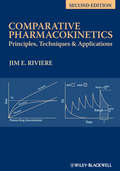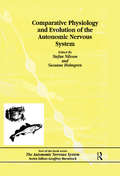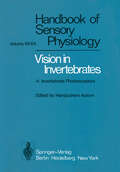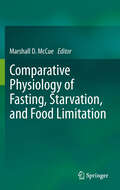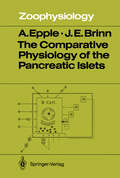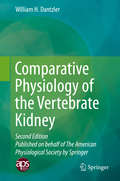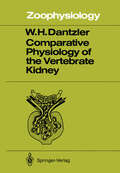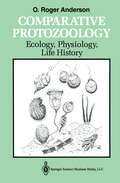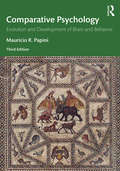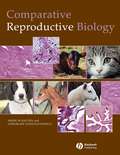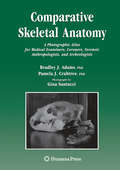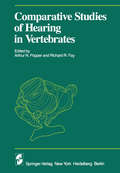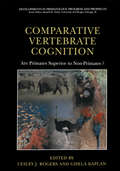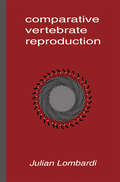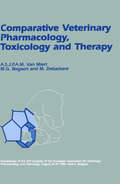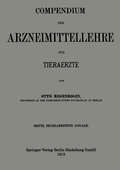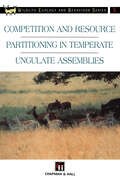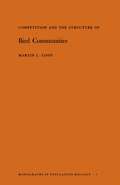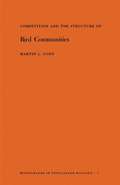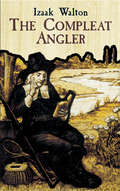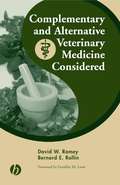- Table View
- List View
Comparative Pharmacokinetics: Principles, Techniques and Applications
by Jim E. RiviereNow in a revised edition, Comparative Pharmacokinetics: Principles, Techniques, and Applications presents the principles and techniques of comparative and veterinary pharmacokinetics in a detailed yet practical manner. Developed as a tool for ensuring that pharmacokinetics studies are properly designed and correctly interpreted, the book provides complete coverage of the conceptual basis of pharmacokinetics as used for quantifying biological processes from the perspectives of physiology and medicine. New chapters have been added on quantitative structure permeability relationships and bioequivalence, and a number of existing chapters have been significantly revised and expanded to provide a current resource for veterinary and comparative pharmacokinetics.
Comparative Physiology and Evolution of the Autonomic Nervous System
by Charlotte B. NilssonComparative Physiology and Evolution of the Autonomic Nervous System, the fourth volume in the Autonomic Nervous System series, is an up-to-date account of the comparative physiology and functional anatomy of the autonomic nervous system, with an emphasis on non-mammalian vertebrates. The book starts with an overview of the field and then discusses both 'classical' (adrenergic and cholinergic) non-adrenergic and non-cholinergic (NANC) types of neurotransmission. The account is then further developed by an examination of the autonomic nervous control of specific systems and organs. Readership: Researchers, working professionals, undergraduates and graduates working in neurology, cardiology, internal medicine, clinical pharmacology, and hypertension.
Comparative Physiology and Evolution of the Autonomic Nervous System
by Charlotte B. NilssonComparative Physiology and Evolution of the Autonomic Nervous System, the fourth volume in the Autonomic Nervous System series, is an up-to-date account of the comparative physiology and functional anatomy of the autonomic nervous system, with an emphasis on non-mammalian vertebrates. The book starts with an overview of the field and then discusses both 'classical' (adrenergic and cholinergic) non-adrenergic and non-cholinergic (NANC) types of neurotransmission. The account is then further developed by an examination of the autonomic nervous control of specific systems and organs. Readership: Researchers, working professionals, undergraduates and graduates working in neurology, cardiology, internal medicine, clinical pharmacology, and hypertension.
Comparative Physiology and Evolution of Vision in Invertebrates: A: Invertebrate Photoreceptors (Handbook of Sensory Physiology #7 / 6 / 6 A)
by H. Autrum M. F. Bennet B. Diehn K. Hamdorf M. Heisenberg M. Järviletho P. Kunze R. Menzel W. H. Miller A. W. Snyder D. G. Stavenga M. YoshidaIn the comparative physiology of photoreception by the Protista and the invertebrates two aspects are emphasized: (1) the diversity of visual processes in these groups and (2) their bearing upon general mechanisms of photoreception. Invertebrates have evolved a far greater variety of adaptations than vertebrates modifications aiding survival in the remarkably different biotopes they occupy. The number of species in itself suggests this multiformity; each of them has peculiarities of its own, in morphology as well as in physiology and behavior. But these special adaptations are variations on a few great themes. Although the catalogue of invertebrate species is immense, the literature concerning them nearly rivals it in extent-even if one considers only that fraction dealing with visual physiology. Taxonomy proceeds by grouping the species, categorizing them in genera, families, orders, and progressively larger units. Similarly, comparative physiology aims at an analogous, more or less compre hensive, classification. This Part A of Volume VII/6, like Part B that follows it, emphasizes the broad questions that concern groups larger than the individual species; in some cases these questions have general applicability. The middle course between approaches that are too specialized and those that are too general is often elusive, but here we attempt to follow it. The vast number of special adaptations-probably, as we have said, as large as the number of species-is beyond the range even of a handbook.
Comparative Physiology of Fasting, Starvation, and Food Limitation
by Marshall D. McCueAll animals face the possibility of food limitation and ultimately starvation-induced mortality. This book summarizes state of the art of starvation biology from the ecological causes of food limitation to the physiological and evolutionary consequences of prolonged fasting. It is written for an audience with an understanding of general principles in animal physiology, yet offers a level of analysis and interpretation that will engage seasoned scientists. Each chapter is written by active researchers in the field of comparative physiology and draws on the primary literature of starvation both in nature and the laboratory. The chapters are organized among broad taxonomic categories, such as protists, arthropods, fishes, reptiles, birds, and flying, aquatic, and terrestrial mammals including humans; particularly well-studied animal models, e.g. endotherms are further organized by experimental approaches, such as analyses of blood metabolites, stable isotopes, thermobiology, and modeling of body composition.
The Comparative Physiology of the Pancreatic Islets (Zoophysiology #21)
by August Epple Jack E. BrinnAs far as we are aware, this is the first attempt to cover the com parative physiology of the pancreatic islets in a monograph. The topics discussed would probably have sufficed to fill about half a dozen monographs, a matter that becomes obvious from a look at the Contents. Hence, we have tried to present the ma terial more in the form of a digest, to emphasize evolutionary perspectives, to point out critical issues, and to identify challenging topics for future research. This approach required an arbitrary reduction of the num ber of references, and we therefore join the chorus of recent authors who beg their colleagues for understanding if some of their publications do not appear in the bibliography. Keeping up with the current literature was like fighting one of those monsters that grow a couple of new heads for each one that is cut off. Nevertheless, we hope that we have covered most of the key publications up to the autumn of 1986. We gratefully acknowledge the advice of many colleagues, and in particular the invaluable criticisms of Robert L. Hazelwood and Erika Plisetskaya. Special thanks are due to the series editor, Donald S. Farner, for his patience and guidance, both of which were fresh proof of his legendary diplomatic skills. Finally, we wish to thank Dr. D. Czeschlik and his staff at the Springer Verlag for their patience and support. Philadelphia, PA AUGUST EpPLE Greenville, NC JACK E. BRINN September 1987 v Contents Chapter 1. Introduction .......................... .
Comparative Physiology of the Vertebrate Kidney (Zoophysiology Ser. #22)
by William H. DantzlerThis second edition offers a comprehensive overview of the physiological functions of vertebrate kidneys from a comparative viewpoint, with particular emphasis on nonmammalian vertebrates. The topics covered include renal structure; glomerular ultrafiltration; tubular transport of inorganic ions, organic substances, and fluid; and urine dilution and concentration. Mammalian renal function is only considered for purposes of comparison with nonmammalian renal function and as a frame of reference for some of the discussions. The major findings on nonmammalian renal function and the important unanswered questions raised by those findings are described in detail. As such, the book provides comprehensive information on comparative renal function for biological scientists and advanced students of biology with some knowledge of physiology and a desire to know more about renal function in vertebrates, and for mammalian renal physiologists who wish to obtain a broader view of renal function.
Comparative Physiology of the Vertebrate Kidney (Zoophysiology #22)
by William H. DantzlerThis volume emphasizes the comparative approach to under standing vertebrate renal function. I am convinced that this approach is of particular value in understanding both the details of renal function at the cellular and subcellular levels and the renal role in regulating fluid volumes and solute concentrations. My exposure to this approach first occurred during a student research experience in the laboratory of Wilbur H. Sawyer, who also provided an introduction to the works of Homer W. Smith and August Krogh. The importance of this approach was reinforced by doctoral and postdoctoral research in the laboratory of Bodil Schmidt-Nielsen. It has been confirmed through years of personal experience since then. My research and my understanding of renal function have been aided through the years by collaboration and discussion with numerous students and associates. Of particular impor tance in developing my views on comparative renal function, and especially on the relationship of structure to function, has been my long association with my colleague and friend, Eldon J. Braun. Donald S. Farner, who suggested the writing of this volume, provided valuable editorial assistance. Much of my personal research in this area has been supported over the years by grants from the United States National Science Foundation and National Institutes of Health. The writing of this volume was completed while I was in Wiirzburg, Federal Republic of Germany, supported by a Senior U.S. Scientist Award from the Alexander von Humboldt Foundation.
Comparative Protozoology: Ecology, Physiology, Life History
by Orvil Roger AndersonThe protozoa are an eclectic assemblage of organisms encompassing a wide range of single-celled and multiple-celled colonial organisms lacking tissue organiza tion, but exhibiting remarkably refined biological behavior. In some modern classifications, they are classified as a subkingdom among the Protista (eukary otic single-celled organisms). Although they are not considered a formal cate gory by some taxonomists and some biologists consider the name inappropriate (inferring that they are the first unicellular animals, although some photosynthe size), it is still convenient to consider this group of organisms as an informal collection under the heading of protozoa. Their cosmopolitan distribution, sig nificant ecological role in mineral recycling and enhancement of carbon flow through lower trophic levels of food webs, and remarkable cellular adaptations to enhance survival in diverse environments make them significant organisms for biological investigation. In some cases, biologists are introduced to this group in first level courses or in invertebrate zoology, but never develop a full appreciation for the diverse and biologically sophisticated characteristics of these organisms. This book is intended as a survey of broad concepts in protozoan biology with an emphasis on comparative data. The focus is on the zoological aspects of the group. Topics more closely related to plantlike characteristics, as presented in books on phycol ogy, are not considered in detail here. A sound background in modern biology and an introduction to cellular biology will be helpful in understanding Chapters 15 and 16, which include a substantial amount of information on biochemistry.
Comparative Psychology: Evolution and Development of Brain and Behavior, 3rd Edition
by Mauricio R PapiniThis revised third edition provides an up to date, comprehensive overview of the field of comparative psychology, integrating both evolutionary and developmental studies of brain and behavior. This book provides a unique combination of areas normally covered independently to satisfy the requirements of comparative psychology courses. Papini ensures thorough coverage of topics like the fundamentals of neural function, the cognitive and associative capacities of animals, the development of the central nervous system and behavior, and the fossil record of animals including human ancestors. This text includes many examples drawn from the study of human behavior, highlighting general and basic principles that apply broadly to the animal kingdom. New topics introduced in this edition include genetics, epigenetics, neurobiological, and cognitive advances made in recent years into this evolutionary-developmental framework. An essential textbook for upper level undergraduate and graduate courses in comparative psychology, animal behavior, and evolutionary psychology, developmental psychology, neuroscience and behavioral biology.
Comparative Psychology: Evolution and Development of Brain and Behavior, 3rd Edition
by Mauricio R PapiniThis revised third edition provides an up to date, comprehensive overview of the field of comparative psychology, integrating both evolutionary and developmental studies of brain and behavior. This book provides a unique combination of areas normally covered independently to satisfy the requirements of comparative psychology courses. Papini ensures thorough coverage of topics like the fundamentals of neural function, the cognitive and associative capacities of animals, the development of the central nervous system and behavior, and the fossil record of animals including human ancestors. This text includes many examples drawn from the study of human behavior, highlighting general and basic principles that apply broadly to the animal kingdom. New topics introduced in this edition include genetics, epigenetics, neurobiological, and cognitive advances made in recent years into this evolutionary-developmental framework. An essential textbook for upper level undergraduate and graduate courses in comparative psychology, animal behavior, and evolutionary psychology, developmental psychology, neuroscience and behavioral biology.
Comparative Reproductive Biology
by Heide Schatten Gheorghe M. ConstantinescuWhen considering the physiological systems of the body, the degree of species variation within the reproductive system compared to other systems is remarkable. Furthermore, it is essential that researchers, educators, and students alike remain aware of the fundamental comparative differences in the reproductive biology of domestic species. Written by renowned scientists in their respective fields, Comparative Reproductive Biology is a comprehensive reference on the reproductive systems of domestic species. The book offers both broad and specific knowledge in areas that have advanced the field in recent years, including advances in cell and molecular biology applied to reproduction, transgenic animal production, gender selection, artificial insemination, embryo transfer, cryobiology, animal cloning and many others. This seminal text includes topics in animal reproduction that are usually only found as part of other books in animal science such as anatomy, histology, physiology, radiology, ultrasonogrophy, and others. Comprehensive reference of the reproductive systems of domestic species Written by a team of top researchers Richly illustrated throughout, including 12 pages of color images
Comparative Skeletal Anatomy: A Photographic Atlas for Medical Examiners, Coroners, Forensic Anthropologists, and Archaeologists
by Bradley J. Adams Pamela J. CrabtreeThis is a photographic atlas of common animal bones, designed for use by the forensic scientist or archaeologist. This volume is the first to focus comparatively on both human and animal osteology. It features more than 300 illustrations of skeletons. Throughout, animal bones are photographed alongside the corresponding human bone, allowing the reader to observe size and shape variations.
Comparative Studies of Hearing in Vertebrates (Proceedings in Life Sciences)
by A. N. Popper R. R. FayThe past two decades have seen an extraordinary growth of interest in the auditory mechanisms of a wide range of vertebrates and invertebrates. Investigations have ranged from auditory mechanisms in relatively simple animals where just a few cells are em ployed for detection of sound, to the highly complex detection and processing systems of man and the other mammals. Of particular significance to us has been the growing interest in general principles of vertebrate auditory system organization, as opposed to a specific and limited concern for the mammalian or even human systems. Some of the interest in nonmammalian systems has risen from the desire to fmd simpler experi mental models for both the essential components (e. g. , the hair cell receptor) and the more complex functions (e. g. , frequency analysis) of all vertebrate auditory systems. Interest has also risen from questions about the evolution of hearing and the covariation (or lack of it) in structure and function in a wide variety of biological solutions to the problems of acoustic mechanoreception. Of course, the desire to fmd simpler experi mental models and the need to answer questions about the evolution of hearing are not unrelated. In fact, detailed analyses of a variety of systems have led several times to the realization that some of the "simple systems" are more complex than initially thought.
Comparative Vertebrate Cognition: Are Primates Superior to Non-Primates? (Developments in Primatology: Progress and Prospects #No. 3)
by GiselaKaplan Lesley J. RogersThis book explores afresh the long-standing interest, and emphasis on, the `special' capacities of primates. Some of the recent discoveries of the higher cognitive abilities of other mammals and also birds challenge the concept that primates are special and even the view that the cognitive ability of apes is more advanced than that of nonprimate mammals and birds. It is therefore timely to ask whether primates are, in fact, special and to do so from a broad range of perspectives. Divided into five sections this book deals with topics about higher cognition and how it is manifested in different species, and also considers aspects of brain structure that might be associated with complex behavior.
Comparative Vertebrate Reproduction
by Julian LombardiComparative Vertebrate Reproduction is the only comprehensive textbook covering major topics in the reproductive biology of vertebrates, from sexuality and gametogenesis to reproductive ecology and life history tactics. The work draws heavily on recent reviews and papers while placing topics in a historical context and conceptual framework. In addition, the author provides detailed comparative surveys of each of the major topics discussed. Comparative Vertebrate Reproduction has been written as a textbook for upper-level undergraduate and graduate-level students in biology, zoology, physiology, animal science, and veterinary medicine. The work also serves as an excellent reference for researchers in medical and veterinary schools working in reproductive medicine.
Comparative Veterinary Pharmacology, Toxicology and Therapy: Proceedings of the 3rd Congress of the European Association for Veterinary Pharmacology and Toxicology, August 25–29 1985, Ghent, Belgium Part II, Invited Lectures
by A. S. J. P. A. M. Van Miert M. G. Bogaert M. DebackereThe third congress ofthe European Association for Veterinary Pharmacology and Toxicol ogy (EAVPT) was held in Ghent, Belgium, from 25 to 29 August 1985. Part I of the Proceedings of this congress contains the abstracts of all invited lectures, oral communi cations and poster communications, presented at the congress. The invited lectures are now published (this volume) in extenso as Part II of the Proceedings. The editors wish to thank all invited speakers for their active contribution to the success of the third congress of EAVPT. They are very grateful to Dr. P. De Backer for compiling all manuscripts, Dr. P. Lees for scientific amendments, Miss B. Vermeesch and Dr. R. Lefebvre for preparing the camera ready copy and MTP Press for literary advice and publishing. A. S. J. P. A. M. van Miert M. G. Bogaert M. Debackere xi Contributors AMEND J.F. Department of Anatomy and Physiology, Atlantic Veterinary College. University of Prince Edward Island. Charlotte town. P.E.I. CIA 4P3. Canada. ANIKA S.M. Department of Veterinary Physiology and Pharmacology. University of Nigeria, Nsukka. Nigeria. ARGENZIO R.A. Department of Anatomy, Physiological Sciences. and Radio logy, School of Veterinary Medicine. North Carolina State University. Raleigh, NC 27606. USA. ARONSON A.L. Clinical Pharmacology Unit. School of Veterinary Medicine. North Carolina State University, Raleigh. North Carolina 27606. USA. AUCOIN D.P. The Animal Medical Center. 510 E 62nd Street. New York. New York 10021. USA. xiii xiv COMPARATIVE VETERINARY PHARMACOLOGY, TOXICOLOGY AND THERAPY BAARS A.J.
Compendium der Arzneimittellehre für Tieraerzte
by Otto RegenbogenDieser Buchtitel ist Teil des Digitalisierungsprojekts Springer Book Archives mit Publikationen, die seit den Anfängen des Verlags von 1842 erschienen sind. Der Verlag stellt mit diesem Archiv Quellen für die historische wie auch die disziplingeschichtliche Forschung zur Verfügung, die jeweils im historischen Kontext betrachtet werden müssen. Dieser Titel erschien in der Zeit vor 1945 und wird daher in seiner zeittypischen politisch-ideologischen Ausrichtung vom Verlag nicht beworben.
Compétences pour minimiser le stress chez les professionnels de santé - E-BOOK: Compétences pour minimiser le stress chez les professionnels de santé - E-BOOK
by Shannon DamesDéveloppez la résilience et prospérez en tant que professionnel des soins ! Compétences pour minimiser le stress chez les professionnels de santé : un guide pour renforcer votre racines aborde des méthodes pour prendre soin de soi et prévenir la fatigue émotionnelle et l’épuisement professionnel dans les milieux de travail très stressants. Ce livre utilise une approche factuelle qui examine comment les professionnels de la santé peuvent développer l’autocompassion, la pleine conscience, les relations avec leurs collègues et leur satisfaction en leur carrière. Rédigé par Shannon Dames, enseignante et chercheuse réputée, ce manuel pratique montre comment mettre en pratique ces connaissances et améliorer votre bien-être dans de vrais contextes de soins. En raison de la prévalence plus élevée chez les professionnels de la santé de problèmes de santé mentale comme le syndrome de stress post-traumatique (SSPT) et le trouble dépressif majeur (TDM) une ressource comme celle-ci n’a jamais été aussi nécessaire !Focaliser à la fois sur la théorie et la pratique permet aux étudiants de s’autoévaluer, de renforcer leur résilience et de s’épanouir, grâce à des concepts soutenus par la recherche.UNIQUE ! Les études de cas Parcours illustrent l’expérience ou les préoccupations réelles d’un professionnel de la santé, ce qui amène les étudiants à réfléchir, pendant leur lecture, à la façon dont ils géreraient la situation exposée. La fin du chapitre propose une méthode efficace pour gérer la situation, et démontre comment mettre en pratique les leçons apprises.UNIQUE ! L’écriture claire sur le ton de la conversation et le cadre métaphorique des racines et de l’arbre établissent un lien avec les lecteurs et facilitent l’apprentissage conceptuel.Des exercices pratiques intégrés permettent aux étudiants de développer et de renforcer leurs propres racines métaphoriques.Des vignettes tout au long du texte démontrent comment les concepts s’appliquent aux scénarios du monde réel.S’adapter au parcours à venir résume le contenu à la fin de chaque chapitre pour que les étudiants comprennent bien les concepts principaux.UNIQUE ! Des encadrés présentant la contribution du Dr Crosbie Watler, M.D., FRCPC aident les étudiants à naviguer et à comprendre les enjeux en santé mentale qui touchent les professionnels de la santé.
Competition and Resource Partitioning in Temperate Ungulate Assemblies (Chapman & Hall Wildlife Ecology and Behaviour Series)
by R.J. PutmanRory Putman addresses the question of how, in many temporate ecosystems, diverse and species-rich assemblies of ungulates manage to co-exist despite often quite extensive overlap in ecological requirements. Putman explores the potential for competition, competition tolerance and even positive facilitation amongst the members of such guilds of ungulates. As a central worked example, the author employs data resulting from over 20 years of personal research into the ecology and population dynamics of various large herbivores of the New Forest in Southern England. With these, he applies formal protocols in resource use, evidence for resource limitation and evidence for interaction between species in changing population size over the years.
Competition and the Structure of Bird Communities. (Monographs in Population Biology #92)
by Martin L. CodyProfessor Cody's monograph emphasizes the role of competition at levels above single species populations, and describes how competition, by way of the niche concept, determines the structure of communities. Communities may be understood in terms of resource gradients, or niche dimensions, along which species become segregated through competitive interactions. Most communities appear to exist in three or four such dimensions. The first three chapters describe the resource gradients (habitat types, foraging sites, food types), show what factors restrict species to certain parts of the resource gradients and so determine niche breadths, and illustrate the important role of resource predictability in niche overlap between species for resources they share. Most examples are drawn from eleven North and South American bird communities, although the concepts and methodology are far more general. Next, the optimality of community structure is tested through parallel and convergent evolution on different continents with similar climates and habitats, and the direct influence of competitors on resource use is investigated by comparisons of species--poor island communities to species-rich mainland ones. Finally, the author discusses those sorts of environments in which the evolution of one species--one resource set is not achieved, and where alternative schemes of resource allocation, often involving several species that act ecologically as one, must be followed.
Competition and the Structure of Bird Communities. (MPB-7), Volume 7 (PDF)
by Martin L. CodyProfessor Cody's monograph emphasizes the role of competition at levels above single species populations, and describes how competition, by way of the niche concept, determines the structure of communities. Communities may be understood in terms of resource gradients, or niche dimensions, along which species become segregated through competitive interactions. Most communities appear to exist in three or four such dimensions. The first three chapters describe the resource gradients (habitat types, foraging sites, food types), show what factors restrict species to certain parts of the resource gradients and so determine niche breadths, and illustrate the important role of resource predictability in niche overlap between species for resources they share. Most examples are drawn from eleven North and South American bird communities, although the concepts and methodology are far more general. Next, the optimality of community structure is tested through parallel and convergent evolution on different continents with similar climates and habitats, and the direct influence of competitors on resource use is investigated by comparisons of species--poor island communities to species-rich mainland ones. Finally, the author discusses those sorts of environments in which the evolution of one species--one resource set is not achieved, and where alternative schemes of resource allocation, often involving several species that act ecologically as one, must be followed.
The Compleat Angler: Or, Contemplative Man's Recreation
by Izaak WaltonFirst published in 1653, this literary and nature classic was created by a Londoner with a passion for rustic life. As satisfying a primer on fishing as any angler could wish, it celebrates the art and spirit of fishing with verse, song and folklore, moral reflections, and timeless wisdom. Cast in the form of a dialogue between the veteran angler Piscator and his pupil Viator, it both informs and delights with an ingenious exploration of fishing's subtle intricacies and the pleasures of the natural world.
Complementary and Alternative Veterinary Medicine Considered
by David W. Ramey Bernard E. RollinComplementary and Alternative Veterinary Medicine Considered is a book that belongs in your veterinary library. If you are a veterinarian wondering if you should incorporate complementary and alternative veterinary medicine (CAVM) into your practice, if you have recently hired an associate eager to try such things as acupuncture or homeopathy, or if you have clients asking you about chiropractic, herbal, or magnetic field therapy for their pets, you’ll want to understand the history, science and ethics behind such therapies. In its 2001 Guidelines for Complementary and Alternative Medicine, the American Veterinary Medical Association (AVMA) recognizes the growing interest in CAVM, and encourages the critical examination of these therapies using the scientific method. Following the AVMA’s lead on this subject, Complementary and Alternative Veterinary Medicine Considered thoroughly examines a variety of CAVM therapies and asks important questions regarding alternative treatments. For example, is acupuncture effective in pain relief? What is homeopathy? What is the history behind chiropractic? What does the research say (and not say) about various CAVM modalities? And, just as importantly, what are the ethical and regulatory considerations concerning such therapies? This book has the answers to those questions and more. Complementary and Alternative Veterinary Medicine Considered will help practicing veterinarians to make informed decisions about specific CAVM therapies. This text evaluates various prevalent therapies, and will give veterinarians the ethical and scientific bases they need to make sound decisions regarding CAVM therapies Coverage includes but is not limited to: Acupuncture and acupressure; Energy medicine; Manual therapy (chiropractic); Manual therapy (massage); Magnetic and electromagnetic therapy; Laser and light therapy; Homeopathy; and Herbal therapy.
Complementary Medicine for Veterinary Technicians and Nurses
by Nancy ScanlanComplementary Medicine for Veterinary Technicians and Nurses is the first resource on holistic veterinary care written specifically for the veterinary technician. Organized by treatment modality, the book offers practical information designed to help readers develop an understanding of each modality, assist with procedures associated with holistic medicine, and knowledgeably discuss treatment options with clients. Outlining the respective roles of technicians and veterinarians throughout, this book is a welcome reference for readers looking to expand their knowledge of complementary veterinary medicine and introduce additional treatment options in their practice.
